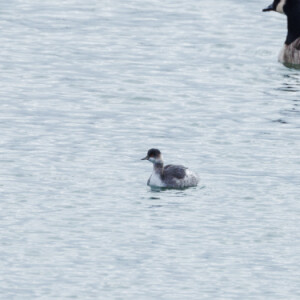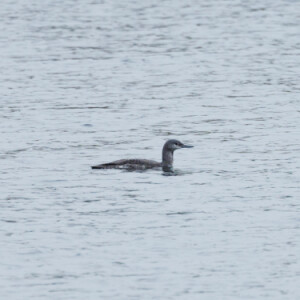Twitchy
I'm not a twitcher - not least because I abhor crowds - but every now and then I see some bird alerts that make me think Well really - it would be rude not to go and take a look. This was the case today, when I read that the old gravel workings at Grimley were still hosting both a Black-necked Grebe and a Red-throated Diver. The Grebe has actually been there for a few days, but though I'd never seen one before it wasn't enough of a draw on its own to get me crossing the county. When the Diver showed up yesterday though, and was still being reported this morning, the deal was clinched.
Having driven for fifty minutes each way and trudged back and forth across muddy fields, one containing a herd of cows, to reach the pools occupied by my 'rarities', I'm a bit surprised to find myself featuring this Stonechat, but despite the fact that it's a common bird, and notwithstanding all the builders' rubbish in the background, this has turned out to be my favourite photo of the day. After putting in all that effort I really have to post the Grebe and the Diver as well, but it has to be said that with limited access to the pools Grimley is a better spot for scoping birds than for photographing them, so the images are just heavily cropped record shots.
The first extra shows the Black-necked Grebe, which is a genuinely rare bird: there are estimated to be fewer than 50 breeding pairs in the UK, concentrated in central and eastern England. The winter population increases to around 130 birds, and a few more make temporary stop-overs during the autumn and spring migrations. For breeding, the Black-necked Grebe favours shallow inland water with plenty of emergent vegetation, but in winter it can mainly be found in sheltered coastal waters and estuaries, as well as on reservoirs. There's a good film here from the BTO, comparing and contrasting the five species of Grebe we have in the UK in their pale winter plumage.
My third photo shows the Red-throated Diver - a bird so pale and grey that it was genuinely difficult to see at a distance on pale grey water. This is the smallest of the UK's three species of Diver, and by far the most numerous. Around 1,200 pairs breed in Scotland, mainly in Shetland and Orkney, but in winter the population is swelled to as many as 17,000 individuals by migrants from Europe and Iceland. Wintering birds can be found all around the coast of the UK, but they rarely turn up inland, and it's likely that this bird is making a temporary stop to rest and feed, en route to a more permanent winter home. Once again there's a nice video here from the BTO that shows the differences in size, shape, and winter plumage of the three UK Diver species.



Comments
Sign in or get an account to comment.


